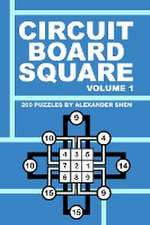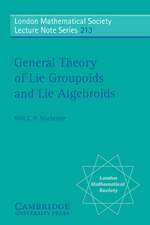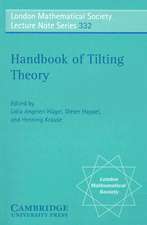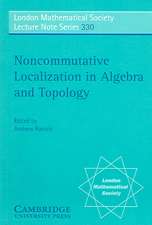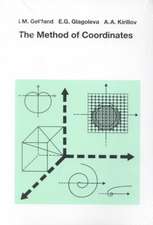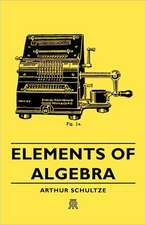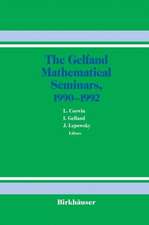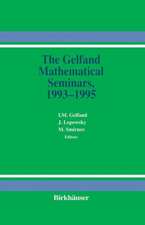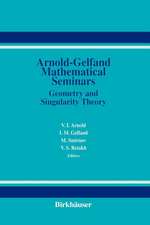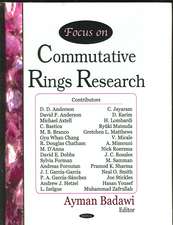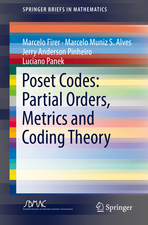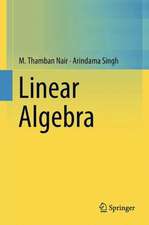Algebra
Autor I. M. Gelfand, Alexander Shenen Limba Engleză Paperback – 17 sep 1993
Preț: 360.42 lei
Preț vechi: 434.25 lei
-17% Nou
Puncte Express: 541
Preț estimativ în valută:
68.96€ • 72.01$ • 57.08£
68.96€ • 72.01$ • 57.08£
Carte tipărită la comandă
Livrare economică 04-18 aprilie
Preluare comenzi: 021 569.72.76
Specificații
ISBN-13: 9780817636777
ISBN-10: 0817636773
Pagini: 160
Ilustrații: 160 p. 3 illus.
Dimensiuni: 155 x 235 x 13 mm
Greutate: 0.23 kg
Ediția:2004
Editura: Birkhäuser Boston
Colecția Birkhäuser
Locul publicării:Boston, MA, United States
ISBN-10: 0817636773
Pagini: 160
Ilustrații: 160 p. 3 illus.
Dimensiuni: 155 x 235 x 13 mm
Greutate: 0.23 kg
Ediția:2004
Editura: Birkhäuser Boston
Colecția Birkhäuser
Locul publicării:Boston, MA, United States
Public țintă
Lower undergraduateCuprins
1 Introduction.- 2 Exchange of terms in addition.- 3 Exchange of terms in multiplication.- 4 Addition in the decimal number system.- 5 The multiplication table and the multiplication algorithm.- 6 The division algorithm.- 7 The binary system.- 8 The commutative law.- 9 The associative law.- 10 The use of parentheses.- 11 The distributive law.- 12 Letters in algebra.- 13 The addition of negative numbers.- 14 The multiplication of negative numbers.- 15 Dealing with fractions.- 16 Powers.- 17 Big numbers around us.- 18 Negative powers.- 19 Small numbers around us.- 20 How to multiply am by an, or why our definition is convenient.- 21 The rule of multiplication for powers.- 22 Formula for short multiplication: The square of a sum.- 23 How to explain the square of the sum formula to our younger brother or sister.- 24 The difference of squares.- 25 The cube of the sum formula.- 26 The formula for (a + b)4.- 27 Formulas for (a + b)5, (a + b)6,... and Pascal’s triangle.- 28 Polynomials.- 29 A digression: When are polynomials equal?.- 30 How many monomials do we get?.- 31 Coefficients and values.- 32 Factoring.- 33 Rational expressions.- 34 Converting a rational expression into the quotient of two polynomials.- 35 Polynomial and rational fractions in one variable.- 36 Division of polynomials in one variable; the remainder.- 37 The remainder when dividing by x - a.- 38 Values of polynomials, and interpolation.- 39 Arithmetic progressions.- 40 The sum of an arithmetic progression.- 41 Geometric progressions.- 42 The sum of a geometric progression.- 43 Different problems about progressions.- 44 The well-tempered clavier.- 45 The sum of an infinite geometric progression.- 46 Equations.- 47 A short glossary.- 48 Quadratic equations.- 49 The case p =. Square roots.- 50 Rules forsquare roots.- 51 The equation x2 + px + q =.- 52 Vieta’s theorem.- 53 Factoring ax2 + bx + c.- 54 A formula for ax2 + bx + c = (where a ? 0).- 55 One more formula concerning quadratic equations.- 56 A quadratic equation becomes linear.- 57 The graph of the quadratic polynomial.- 58 Quadratic inequalities.- 59 Maximum and minimum values of a qua ratic polynomial.- 60 Biquadratic equations.- 61 Symmetric equations.- 62 How to confuse students on an exam.- 63 Roots.- 64 Non-integer powers.- 65 Proving inequalities.- 66 Arithmetic and geometric means.- 67 The geometric mean does not exceed the arithmetic mean.- 68 Problems about maximum and minimum.- 69 Geometric illustrations.- 70 The arithmetic and geometric means of everal numbers.- 71 The quadratic mean.- 72 The harmonic mean.
Recenzii
“The
idea
behind
teaching
is
to
expect
students
to
learn
why
things
are
true,
rather
than
have
them
memorize
ways
of
solving
a
few
problems,
as
most
of
our
books
have
done.
[This]
same
philosophy
lies
behind
the
current
text
by
Gelfand
and
Shen.
There
are
specific
‘practical’
problems
but
there
is
much
more
development
of
the
ideas
…
[The
authors]
have
shown
how
to
write
a
serious
yet
lively
look
at
algebra.” —The
American
Mathematics
Monthly
“Were‘Algebra’to be used solely for supplementary reading, it could be wholeheartedly recommended to any high school student of any teacher … In fact, given the long tradition of mistreating algebra as a disjointed collection of techniques in the schools, there should be some urgency in making this book compulsory reading for anyone interested in learning mathematics.” —The Mathematical Intelligencer
“Were‘Algebra’to be used solely for supplementary reading, it could be wholeheartedly recommended to any high school student of any teacher … In fact, given the long tradition of mistreating algebra as a disjointed collection of techniques in the schools, there should be some urgency in making this book compulsory reading for anyone interested in learning mathematics.” —The Mathematical Intelligencer
Descriere
The best way to deal with them is: Solve the problem by yourself - compare your solution with the solution in the book (if it exists) - go to the next problem. Adding three apples to five apples is the same as adding five apples to three - apples do not disappear and we get eight of them in both cases.

